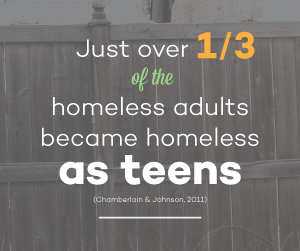Does anyone know how many homeless adults were homeless at some point while growing up? cc: @hardlynormal @homelesshub @naehomelessness
— HomelessYouthProject (@CAHomelessYouth) May 1, 2014
This question is an important one. We tend to study youth who experience homelessness and adults who experience homelessness separately. When we do that we can miss important connections and these connections need to be better understood. If we know why homeless youth become homeless adults we may be able to introduce program responses that can work to prevent this from happening.
This question also highlights some of the challenges in conducting research with persons who are homeless. Homeless youth are a vulnerable and mobile population. It is usually not feasible to follow homeless youth over a long time to determine whether or not they continue experiencing homelessness as they become adults. Most of the information we do know about the connection between youth and adult homelessness comes from asking homeless adults about what happened to them when they were youth. This research tells us something about what distinguishes adults who became homeless when they were youth from other homeless adults.
One study, which gives us an idea on the number of homeless adults who were homeless when they were youth, was done in Australia. Chamberlain and Johnson reviewed case files from two high-volume services in Melbourne that work with persons who are homeless or at risk of being homeless. They read the case files of 3,941 individuals and also did 65 in-depth interviews. The researchers found there were five pathways to adult homelessness (housing crisis, family breakdown, substance abuse, mental health issues and youth to adult). The pathway most relevant to our question is the youth to adult homelessness pathway. The authors found that those who had become homeless when they were 18 years of age or younger made up 35% of all of the homeless adults in the case files. They also found that 85% of the youth to adult cases were in the long term homeless category. The percentage of long term homeless was higher among those in the youth to adult path than in any of the other pathways.
The Chamberlain and Johnson study confirms what other research has shown. The path from youth to adult homelessness usually has its roots in the high rate of abuse and family conflict among homeless youth. Homeless adults report higher rates of adverse childhood events, such as abuse, parental substance abuse, placement in foster care and family conflict, than adults who are not homeless. Some researchers have been able to demonstrate that the experience of childhood trauma is a contributing risk factor for adult homelessness.
We also know that those who are chronically homeless are much more likely than the non-chronically homeless to report childhood abuse, particularly sexual abuse. Research has shown that the experience of childhood abuse is a predictor of chronic adult homelessness.
The Chamberlain and Johnson study suggests that just over one third of the homeless adults became homeless as teens. As in other research, most of this group had experienced traumatic family breakdowns and were more likely to be chronically homeless.
In a study of 100 homeless adults in Niagara, 47% had experienced their first homelessness episode at 18 years of age, with 32% having been sixteen or younger. As in other studies, these adults were also significantly more likely to be chronically homeless.
As part of a study I conducted of homeless youth, I interviewed 20 adults who are or have been chronically homeless and who first became homeless as teens. My conversations with them led me to several conclusions:
- Young people facing abuse and family conflict can lose a sense of “home” as a place of support, comfort and safety long before they become physically homeless.
- Childhood trauma in the form of abuse has had a significant impact on their lives. Sixty percent of the adults had been sexually abused. All of those who had been abused indicated that their childhood experiences had contributed to their adult homelessness.
- Mental illness and/or substance abuse for this population are a response to childhood trauma which has never been addressed. When we separate homeless adults from a life story that moves from childhood trauma to substance abuse to homelessness, we can lose sight of the roots of substance use and mental health issues in childhood trauma. When we lose track of untreated trauma, we fail both youth who experienced homelessness as a result of these events and the chronically homeless adults they may become.
Our response to homelessness, both among youth populations and among chronically homeless adults, must include addressing the impact of the trauma inflicted by adverse childhood events.
McKenzie-Mohr, Coates and McLeod make the case for including trauma-informed care as a part of our response to youth homelessness. The trauma informed care which they describe includes responding to the impact of trauma, providing a place of safety and respect for youth and paying attention to the life circumstances of those who are homeless. It isn’t enough to address childhood trauma by adding on a piece of programming meant to fix traumatized individuals. Recognizing this, the authors argue for a politicized approach which includes, “strong social policies, community development initiatives, health and wellness opportunities for families, and quality education services”.


